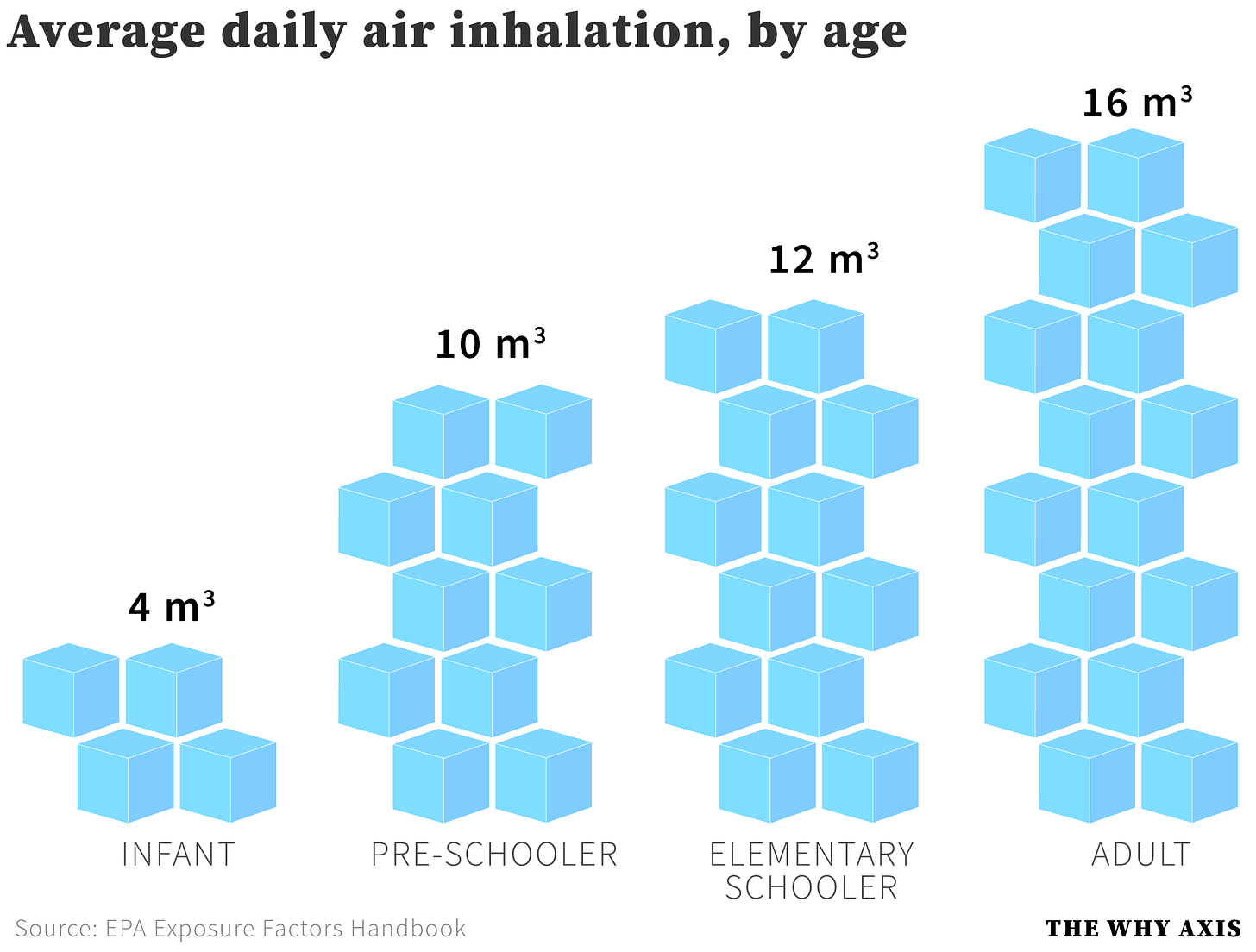Why dirty air hurts kids more
It's counterintuitive, but pound for pound kids inhale more pollutants than adults do
Pretty much every air pollution study in existence will tell you that dirty air is more harmful to kids than adults. And this isn’t just because children’s bodies are still developing (although that’s certainly part of it) — pound for pound, children actually breathe in more pollutants than adults do. It took me a while to wrap my head around this fact. After all, kids are smaller than adults, and thus have lower lung capacities, and so in the end it should all kind of wash out, right?
Well, no. And to understand why, it might help to break out some visual aids.
So let’s start with this cube. This cube represents 1 cubic meter of air — all the air that fits in a box that’s 3 feet long by 3 feet wide by 3 feet tall.
In the course of a typical day, the average newborn will inhale and exhale about four of these cubes, or four cubic meters.
This number, like most of the numbers in this piece, comes from the EPA’s Exposure Factors Handbook, which basically contains all the benchmark measures they use to assess human exposure to various types of pollutants. The individual numbers and averages are derived from various published studies.
As you get bigger and your lungs grow with you, you breathe in more air over the course of a day. A typical fourth grader, for instance, might inhale 12 cubic meters a day. For an average middle-aged adult it’s closer to about 16.
So in simple raw number terms, adults breathe in more air in the course of a day than kids do. But here’s the rub: in order to properly measure exposure to something like a toxin or a pollutant, we need to adjust these numbers for bodyweight. A shot of whiskey, for instance, will affect a 200-pound person less than a 100-pound person. The same goes for a “shot” of air pollution, however you might define it.
This diagram shows how much air a person breathes per kilogram of average bodyweight at each age. A four-kilo newborn, for instance, is breathing in about a full cubic meter of air per kilogram of weight each day. But that number shrinks as you get older: elementary schoolers process a little less than half a cubic meter of air per kilo, while adults breathe in only about one-fifth.
So the typical infant might be breathing in five times as much air, per kilogram of bodyweight, than the typical adult. If that air contains pollutants like smog or car exhaust, like pretty much all of our air does, that poor kid is going to be exposed to it at five times the rate an adult would.
The chief reason for this, incidentally, is that little kids breathe a lot faster than adults do. A newborn at rest might take fifty breaths per minute, while a sedentary adult is only taking 12 to 15.
These are all basically just back-of-the-envelope calculations and there are a lot of other factors that can affect them. But as I understand it, most of those factors widen the exposure ratio between kids and adults. Kids tend to be a lot more active than adults, meaning they spend more time at elevated levels of cardiovascular workload. They also tend to spend more time outside, meaning they’re more likely to be huffing in raw unfiltered wildfire smoke, tailpipe exhaust, or whatever else is floating around. Some research has even found that pollution is more concentrated at little kid height in the air column than at adult height, further bolstering children’s exposure relative to adults.
It’s also worth noting that there’s a lot more variation among kids when it comes to air inhalation. The top 5 percent of newborns, for instance, breathe in almost twice as much air in a typical day as the average newborn, for instance. The top 5 percent of adults, by contrast, only breathe in about 30 percent more air than the average grown-up. Among kids, in other words, there’s much greater potential for harm at the tail end of the distribution.
In the end, air pollution is kind of a double-whammy for kids: not only does it mess them up more because their bodies are still developing (and hence more vulnerable to disruption). They’re also just processing a lot more of the stuff than adults are. The dose makes the poison, as toxicologists are fond of saying. That’s as true of polluted air as it is of anything else.







